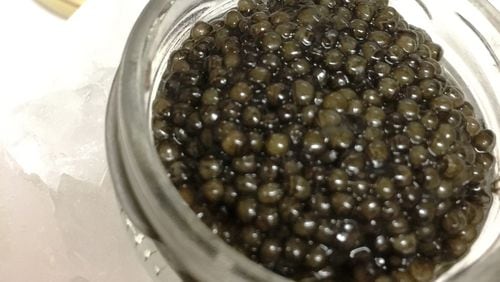The term “caviar” refers to the salted eggs of a sturgeon.
Other treated fish eggs (also called “roe”) of any number of a variety of fish may also be labeled “caviar” but If the label just says “caviar” then what’s inside the jar must be the eggs of sturgeon. If the eggs are from any other fish, then the label must specify the variety of fish such as “salmon caviar” or “paddlefish caviar.”
RELATED:
Atlanta restaurants share recipes made with caviar for your next party
There are dozens of varieties of caviar. Inland Seafood, for example, distributes seventeen. Here are just a few of the most popular.
Caviar from sturgeon that lived in the Caspian Sea is still the world standard and comes in three varieties:
- Beluga is the most expensive caviar with large buttery steel-gray pearls. The lighter the color of the eggs, the more prized the caviar.
- Ossetra falls in the middle range of these caviars, with a stronger taste and smaller eggs than Beluga.
- Sevruga eggs are generally the smallest size eggs and offer a distinctly crunchy texture and the most intense flavor.
Other varieties of caviar include:
American Bowfin: This inexpensive caviar is very popular for its spicy kick and mildly tangy flavor. It’s harvested from a fish that grows in Louisiana and is locally called “choupique.”
American Hackleback: These are the eggs of a wild sturgeon native to the rivers and lakes of Tennessee and Illinois. It’s generally glossy black with medium-size eggs.
American Paddlefish: This caviar is usually steel gray to golden gray and has a buttery flavor. It’s from freshwater sturgeon that live in the lakes and rivers of Mississippi, Kentucky and Tennessee.
Lumpfish: This inexpensive form of caviar is generally dyed red or black and is frequently quite salty. Lumpfish are oily fish that grow in the North Atlantic.
Salmon: These large eggs are sometimes described as orange or peach in color. The large eggs are from salmon that grow in Canada, the United States and Russia.
Trout: Like salmon roe, trout roe is generally red-orange. It’s harvested from freshwater trout from inland lakes.
Whitefish: These small eggs come from whitefish native to the U.S. Great Lakes. It’s enjoyed for its milder flavor.
Read more stories like this by liking Atlanta Restaurant Scene on Facebook , following @ATLDiningNews on Twitter and @ajcdining on Instagram .
About the Author






